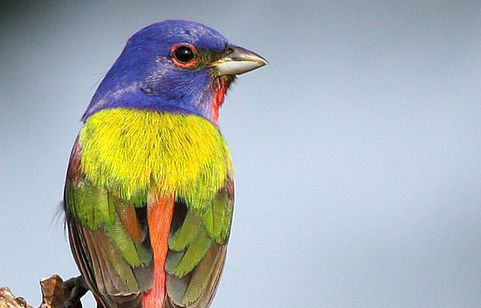The very first time you see that vibrant flash of blue, yellow, red, and green you may think your eyes are deceiving you. Or an exotic pet bird must be lost in the wild. The juxtaposition of tropical colors on a typical Texas landscape is a thrill to see, no matter how many times you’re lucky enough to catch a glimpse of the perfectly monikered Painted Bunting. Many who never envisioned themselves impassioned birders catch the birding bug upon first sight of this medium-sized male finch that seems to have, as so perfectly described by the Cornell Lab of Ornithology, “flown straight out of a child’s coloring book”.
The Uncommon Common
Painted Buntings are fairly common in Texas where they spend their summer before migrating south in the fall to Mexico, Panama, and a number of Caribbean islands. Indeed, Texas appears to contain more nesting Painted Buntings than any other state, with only Oklahoma approaching us in their abundance. But, as Texas Parks & Wildlife notes, that doesn’t mean they’re easily spotted:
“Even though Painted Buntings are fairly common birds in much of Texas they are rarely seen. Their habit of remaining in deep brush except when the male sings early in the morning often cause them to be overlooked. Although primarily seed eaters, Painted Buntings rarely come to backyard feeders because they dislike being so far from cover. They also feed on insects.”
Joni and Jimmy
Like many bird species, the female Painted Bunting is considerably less colorful than her male counterpart. Her more muted green and yellow plumage is a folk singing Joni Mitchell to her troubadour Jimmy Buffet. When searching for a mate, the already showy male really pulls out all the courting stops with a number of enticements including spreading his feathers “like a miniature male turkey”. Painted Buntings typically arrive in Texas from March to May, and breeding season typically extends from late March to late August. The female builds a nest that is a “neat, thin-walled cup of plant fibers, dry leaves and forb stems bound together with spider silk” before laying “3-4 grayish white or pale bluish white eggs, with reddish markings”.
Born after an 11-12 day incubation period, Painted Bunting nestlings may leave the nest as soon as 9 days after hatching to, as described by Texas A&M Agrilife, “cling to a branch or tumble to the ground and scramble or fly back up.” The nestlings are fed by the female who may also be building a new nest at the same time, until the male takes over their care when she begins to lay her second clutch.
Cage-free Conservation
According to the Cornell Lab of Ornithology: “Painted Bunting is regarded as a “species of concern” in the U.S. Fish and Wildlife Service’s Migratory Bird Program Strategic Plan 2004-2014; as a Watch List Species by Partners in Flight (Rich et al. 2004); and as Near-Threatened by BirdLife International. The Painted Bunting also is listed as a Species of Concern in the newly proposed Norma Oficial Mexicana 059 para las Especies Amenazadas y en Peligro.”
So, why the concern and watch lists? Painted Bunting populations are negatively impacted by increasing loss of habitat. Another heartbreaking reason for population decline, thanks to its beautiful plumage and song, is trapping for the cage bird trade – an activity that has been around longer than one would like to think about. The Cornell Lab of Ornithology relates that “in 1841 John James Audubon reported that ‘thousands’ of the colorful birds were caught every spring and shipped from New Orleans to Europe, where they fetched more than 100 times the price when sold as cage birds. They are still trapped and sold in large numbers in Mexico, Central America, the Caribbean, and to a lesser extent in Florida, despite efforts by conservationists to curb illegal trade.”
Anyone with a caged Painted Bunting will never know the uncommon thrill of seeing that wild and free flash of color flown straight out of child’s coloring book.
Have you booked your Landmark Spring Bird Survey yet? When the flowers are blooming and the birds are singing, it is truly one of the most enjoyable wildlife management activities you can do. Contact us today for details.









